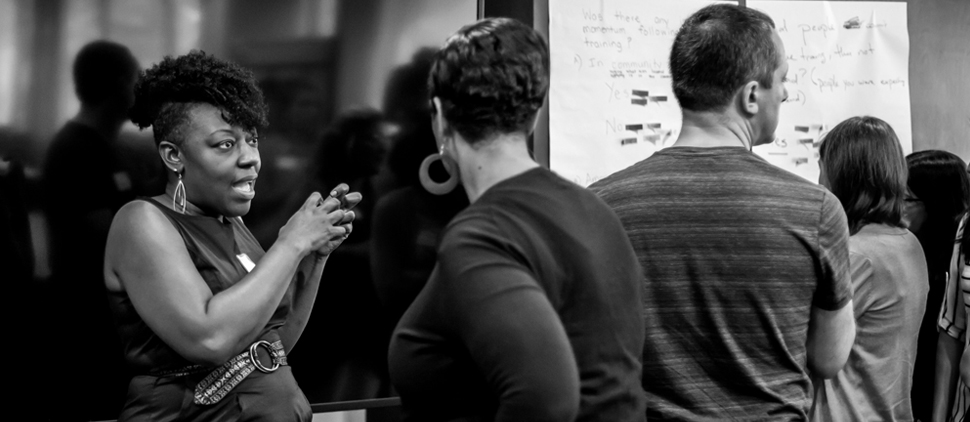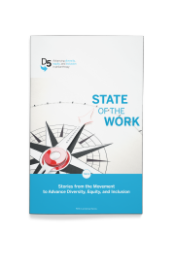Shift toward Diversity and Equity
To achieve its desired impact on social issues, the leadership of the William Caspar Graustein Memorial Fund knew it had to do more than just tackle the issues of race and inequality. It needed the right person to do it.
This story is from the annual D5 State of the Work report.
The William Caspar Graustein Memorial Fund was created as an “expression of love, hope and possibility,” according to Bill Graustein, the son of the man who created it. Archibald Graustein established the family foundation in 1946 to honor his brother, William, a Harvard math professor who had died in a car accident the year before. Their father had died recently as well, several business ventures failed, and hope seemed in short supply. But as a forward-looking gesture, Archibald created a foundation that would support education, to which the Graustein family believed it owed its success in the New World.
After all, Adolph Graustein, the family patriarch, had emigrated from a small town between Warsaw and Gdansk to Boston in the 1870s, and from his humble beginnings as a dairy deliveryman, sent six children to college. College, in turn, launched that generation of Grausteins, women and men alike, into startlingly successful academic, engineering, and business careers.
The Hamden, Connecticut-based foundation’s first big inflection point came in 1993, when money left to Archibald’s widow passed to the trust. Given the hundredfold increase in resources, the foundation had to get more serious about honing its mission, and it settled on improving education with a focus on early childhood. It partnered with communities and statewide partners to build new programs, strengthen existing ones, bolster parental involvement, and train educational leaders. The result has been ambitious projects like the Discovery Initiative, which invested more than $60 million in 54 Connecticut communities and other partners from 2001 through 2015.
“The choice of director reflected the trustees’ decision to pay more attention to the systemic disadvantages of poor people of color.”
Now the Fund is in the midst of a second major shift. Bill Graustein and his trustees had come to feel that the Fund would not make the desired progress addressing social issues unless it more explicitly addressed issues of race and inequality. To oversee that transition, in 2014 it hired as executive director David Addams, a former director of diversity at the ACLU and Vice President of Special Initiatives at the New York Urban League, who had made a mark running the Oliver Scholars in New York City, which identifies promising minority students and prepares them to succeed in top independent high schools and colleges.
According to Bill Graustein, “The choice of director reflected the trustees’ decision to pay more attention to the systemic disadvantage of poor people of color.” A new mission statement, unveiled in 2015, pledges the Fund “to achieve equity in education by working with those affected and inspiring all to end racism and poverty.” And in an open letter posted on the group’s website, Addams said the Fund would fight harder against “seeming acceptance of the status quo” where racial and economic inequality were concerned. In revisiting its mission, the board and staff were “united in our resolve that rigorous attention to equity underlies our future work,” Addams wrote.
For Bill Graustein, the journey towards a new appreciation for diversity and equity was spurred by several factors. First, he came to see his father’s story through a fresh lens. Archibald, a first-generation college student, had felt like an outsider in Harvard’s class of 1905. He often told Bill an anecdote involving a fellow first-generation college friend named Amos White, whom a professor barred from entering a lecture hall one day because he was late (he had been studying in the library, and the clock stopped). Amos protested at first, then left — only to seek out a heating grate through which he could eavesdrop on the lecture. Archibald framed the story as one about resilience, cleverness, and a hunger for self-improvement, but there was another dimension, which he revealed only the final time he related the story to his son, shortly before his death in 1969: Amos was black. Looking at the handful of black faces in photos of that Harvard class — there were very few black students at Harvard then and an only slightly larger number of German-American names — Bill Graustein says, “I began to understand that my own family’s history was deeply rooted in the diversity of this country.”
Bill’s evolution into a proponent of diversity and equity was slow but steady. After the Fund’s expansion in 1993, he gradually shifted his energies from a career as a research geochemist into full-time philanthropic work.
“I started out in this with some good intentions, with a bit of family story as a motivator, and with a whole lot of privileged cluelessness, too,” he says.
Early on, he threw himself into building the Community Leadership Program, which identifies people who yearn to make a difference regardless of credentials or job title and brings them into conversation with one another, providing professional development along the way.
“My own work has been in creating places where people have the opportunity to step out of their cultural comfort zone, but not be punished,” he says. “And what has been personally really energizing is seeing how people respond to that opportunity, and how it corresponds with their yearnings. My sense is that the barriers to greater inclusion and equity aren’t all external. The various ‘isms’ are perpetuated by people’s reluctance to step into a vulnerable space.”
“Diversity is not about the composition of our board — or not just about that — but about what we are doing to actually talk to the people we are affecting.”
The journey has been a family affair. Bill’s daughter, Lisa Graustein, also on the board, has worked as a diversity consultant and at a Boston public charter school, and those experiences, and her insights, have also shaped the Fund’s new direction.
Addams, who is African American, is the hands-on leader executing the new vision. “Having had the experience I’ve had, at the child and family level, I am going to be focused on driving results to that level,” Addams says. “Not just looking at how to change policy and systems, but how are we going to change the lives of children who need help?”
Asked whether it was important that the Graustein Fund turn to a leader of color at this juncture, Addams responds: “I don’t know if it has to be an African American person, but it has to be someone who can bring a missing perspective to the Fund. Part of that is understanding racism as well as — for me — having had the direct experience of coming up from poverty, and experiencing the barriers, and having been raised by a single black mother.” Addams grew up on the South Side of Chicago, in a neighborhood that was, and remains, nearly all black. From there he made the daunting leap to Princeton.
The Fund will continue to attack barriers to achievement within schools and school districts, but, in an interview, Addams says a new focus will be “the barriers outside schools that undermine kids and undermine communities.” Board members and staff members are thinking hard about how to translate the mission statement into new programmatic activity; they hope to present guidelines for the next phase of grant giving by mid-2016. They have begun to reach out to groups in Connecticut that share an equity focus, such as the Sheff Movement, which has fought to desegregate Hartford schools since the late 1980s, as well as to ordinary parents of school-age kids. “We want to drill down and talk to the grass roots,” Addams says. “We want to hear from the most disadvantaged parts of the community.”
Bill Graustein sees an inclusive process of engagement as being nearly as important as the projects that emerge from it. “The main thing is trying not to circle the wagons and doing our planning behind closed doors, and then unveiling new ventures to the communities we work with,” he says. “It really has to be done in partnership. And it is going to evolve and change even as you’re doing it.”
“Diversity,” he adds, “is not about the composition of our board — or not just about that — but about what we are doing to actually talk to the people we are affecting.”
As the Graustein Fund takes a wholehearted step forward into the vulnerable space Bill Graustein speaks of, he reminds his staff — himself, too — of lessons he’s learned through all those difficult cross-cultural conversations he has brokered over the years. “Don’t be afraid of messing up,” he says. “If you are embarking into new territories and behaviors, which is what this is about, you never get it right the first time. You will inevitably stumble the mumble before you walk the talk.”
David Addams chimes in: “You are almost guaranteed to fail, the first time.” In pursuit of the goal of equity for Connecticut’s children, the William Caspar Graustein Fund is willing to stumble, if that’s what progress takes.
Authored by Chris Shea
Read more stories from the movement to advance diversity, equity, and inclusion in D5’s State of the Work report.
 William Caspar Graustein Memorial Fund
William Caspar Graustein Memorial Fund

